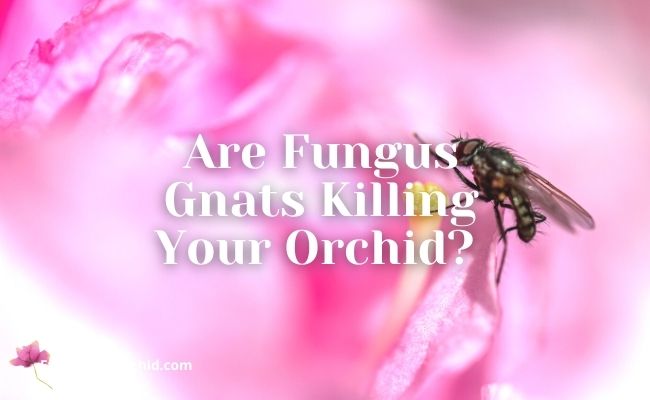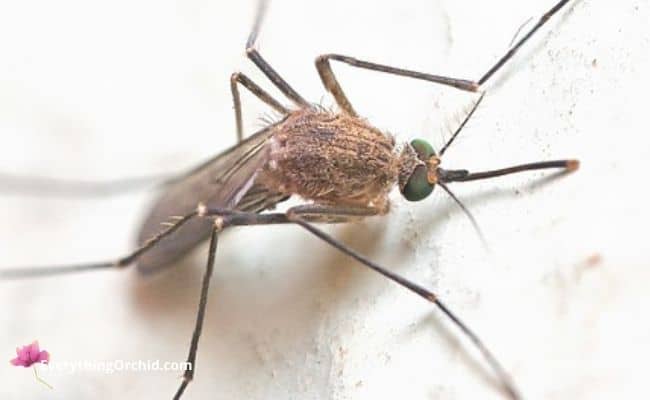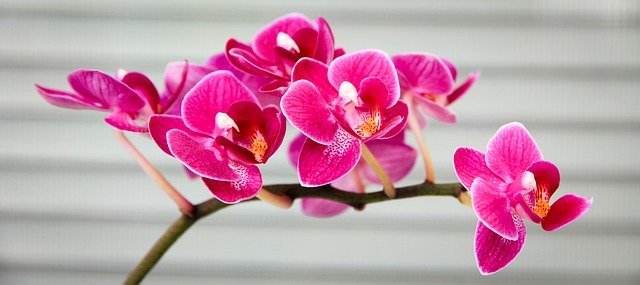Suspect fungus gnats are killing your orchid? Don’t worry! These tiny orchid pests are easy to identify and exterminate.
At some point in our gardening careers, most of us plant lovers encounter some sort of pest at one point or another. It is important that you quickly treat your orchid once you notice any signs of fungus gnats or other pests.
If left untreated, pests can wreck havoc on your plants, which can be potentially fatal to your orchid.
Fungus gnats can easily be exterminated by using several different home remedies or products that are safe for your orchid. In treating your plant, there are several options you can use that will indeed rid your orchid of these tiny pests.
Throughout this blog post you will find information on:
- What fungus gnats are
- Fungus gnat life cycle
- What healthy orchids should look like
- What causes fungus gnats to appear on your plants
- Different treatments and remedies you can use
- How to prevent future fungus gnat invasions
Suspect fungus gnats are killing your orchid? By the end of this article, you will be an expert in being able to identify fungus gnats and exterminate them. Your orchid will bounce back and become healthy again in no time!
FTC Disclosure: This website contains affiliate links. If you choose to purchase any items, EverythingOrchid will receive a commission at no additional cost to you.

Table of Contents
What are Fungus Gnats?
Fungus gnats are one of the many different kinds of gnats that exist today. This type of gnat prefers to invade and inhabit plant potting mediums and soils.
The fungus gnat is found throughout all regions of the world. Insects like the fungus gnat prefer to live on indoor plants, in greenhouses, and in plant nurseries. This insect can rapidly reproduce and spread to all plants that may be in your building or house if left untreated.
Fungus gnats are small, brown, flying insects that tend to be attracted to light. If these insects aren’t roaming around on your orchid (which is rare), you can most likely spot them flying around a window or light.
This type of insect spends most of the day hiding on plants or in the potting medium. Fungus gnats prefer to live in damp, cool areas. They will feed on roots, leaves, and other decomposing materials, especially if they are damp.
Fungus gnats at most live for one month, but in this time, this insect can reproduce several times and lay hundreds of eggs each time. If your orchid becomes infested with fungus gnats, then this pest problem can rapidly get out of control.
If you suspect fungus gnats are killing your orchid or living on your plant, immediately take action and find ways to exterminate this pest.
Fungus Gnat Life Cycle
The life cycle for fungus gnats is fairly short. This insect is born and goes through four phases of life in just 30 days or less.
There are four different life cycles that a fungus gnat will most likely live through. The four stages of a fungus gnat’s life cycle include the egg stage, larvae stage, pupa stage, and adult stage.
Fungus Gnat Life Cycle: Egg and Larvae Stage
The fungus gnat will hatch from an egg (which are usually laid in the potting medium), where it will be born as a larvae.
Fungus larvae are small in size. They are almost impossible to see with the visible eye. Larvae have an elongated, legless body. The body is normally white or clear, with most having a black head.
During this stage, fungus gnat larvae are destructive to orchids and other plants. The larvae mostly feed on decomposing and organic materials, such as soil mulch or dead plant parts and even orchid roots.
Orchid roots are extremely delicate and if harmed, your orchid can potentially die. When fungus gnats chew on roots, they are not only eating them, but are also causing the roots to have open wounds. Open wounds on roots are prone to bacterial and fungal diseases.
Not only will you see your orchid roots begin to disappear, but you may notice things such as black or root rot and other diseases forming. These all can be harmful and even deadly to the entire orchid.
If you notice a fungus gnat on your plant, odds are there are more. The risk of these insects laying eggs in the potting medium are high. Therefore, if you notice any signs of fungus gnats on your orchid, you should immediately begin treatments to not only rid your orchid of the adult gnats, but also the eggs as well.
Again, fungus gnats can reproduce at a rapid rate and your orchid and other household plants can easily become infested with these pests. It is essential to the health of your orchid to immediately kill any fungus eggs, larvae, and adults to prevent mass infestation.
Fungus Gnat Life Cycle: Pupa and Mature Adult Stage
Once the larvae reach 2 weeks old, this is when they will begin to transform into a pupa. The gnat will begin to grow in size and develop features such as legs and wings.
The pupa stage in the life cycle of fungus gnats lasts for approximately four days. In these four days, the gnat will begin to enter the mature adult stage of it’s life cycle.
Adult Fungus Gnats
In this stage, adult fungus gnats will develop wings, legs, and antennas and can grow to be 1/8 of an inch in length. The adult fungus gnat closely resembles a mosquito in appearance.
Mature fungus gnats are fairly harmless to orchids and other plants in the sense that they don’t destroy or eat parts of the plant. The adults are more attracted to light and if found on your plant, they typically just hangout on the leaves or in the soil.
Mature fungus gnats are deadly in the sense that they are able to reproduce at rapid rates. A single fungus gnat is able to reproduce multiple times in this life stage, laying hundreds of eggs at a time.
Once the eggs hatch and become larvae is when this species of pest becomes harmful and dangerous to your orchid.
It is important that if you notice any adult fungus gnats roaming throughout your house or anywhere indoors, that you immediately find proper treatments to kill these pests. This will help in preventing the fungus gnats from laying eggs that hatch into deadly larvae.

Healthy Orchids
It is important to know what a healthy orchid looks like. This will help you know if something is wrong with your orchid, and will help you in determine whether fungus gnats are the cause for any deformities in your orchid.
There are several signs that indicate your orchid is healthy including:
- Strong, light green leaves
- Continuous, vibrant blooming
- Green stems
- Semi-moist soil
- Aerial roots that are silver with green tips
- Soil that allows for good drainage and airflow
- Continuous growth of leaves and roots
- Orchids are pest free
- Orchids are mold and fungus free
If you begin any of these characteristics changing and appear different than what is described above, then this may indicate that your orchid has fungus gnats or other pests and diseases.
Causes of Fungus Gnat Invasions on Orchids
The primary cause for the presence of fungus gnats around your orchid and other household plants is attributed to damp or wet potting mediums and soil.
Excessively wet or damp soil not only attracts fungus gnats, but also causes your orchid to be prone to a number of orchid pests and bacterial or fungal diseases.
Orchid potting soil and potting mediums that remain damp usually results from excessive watering. These types of plants require you to take very specific measures if you want to properly water your orchid and keep it healthy.
The main thing you should do each time before you water your orchid is to check the moisture levels of your soil. Orchid soil should be completely dry before you water your plant again. Damp soil makes the perfect residency for fungus gnats and can cause a numerous of other issues for your plant.
To properly water your orchid, make sure the soil is completely dry. If dry, you should then proceed to give your orchid 3 to 5 ounces of water (you can use ice cubes or liquid water) every 7 to 10 days.
After watering, you should immediately check for any water that may be pooling on the bottom of the pot. If there is water pooling, immediately drain it from the pot to prevent any diseases, infections, or pest invasions.
Signs Fungus Gnats are Killing Your Orchid
The biggest sign you will see that will indicate that fungus gnats are killing your orchid, is based on the roots. Larvae fungus gnats are deadly to orchids and tend to feed on the roots of these plants.
The roots, if being eaten by fungus gnat larvae, will start to become sick. Roots may begin to disappear, form open wounds and infections, become brittle, or die.
Once the roots become impacted, then several problems may arise for your orchid. The roots are responsible for absorbing water and essential nutrients. If the roots are sick or dead, they will be unable to provide the orchid with the things they need to live and grow.
You will start to notice a stunted growth from your orchid. The blooms may begin to fall off. You may also notice the stems and leaves fading and dying as well. Overtime, fungus gnat larvae can take an extreme toll on your plant, and leave you left with a dead orchid if left untreated.
Treatments to Kill Orchid Fungus Gnats
There are several different treatments you can use to get rid of and kill orchid fungus gnats. Most of the treatments will be fairly harmless to your plant and are easy to do.
Different ways you can treat your orchid and kill fungus gnats include:
- Replacing old soil with new mixture
- Using soap and water to kill the bugs
- Completely drying out orchid’s soil
- Apply tea tree oil to your plant’s soil
- Use fungus gnat pesticides
Replace Soil to Kill Orchid Fungus Gnats
Replacing your orchid’s soil can be one of the best treatments you can use to get rid of and kill fungus gnats. New soil will be pest free and full of nutrients.
If your orchid is sitting in soil that is infested with fungus gnats, odds are there are larvae and hundreds of eggs inhabiting the potting medium. You should replace your soil to make sure your orchid is 100% of all traces of fungus gnats.
Orchid soil should be replaced at least once a year regardless of whether or not your plant has pests. Soil breaks down overtime and will lose key nutrients and harm water and airflow. New soil will help in keeping your orchid healthy and less prone to orchid pests and diseases.
Repotting Your Orchid in New Soil
When placing your orchid in new soil, you should only use sphagnum moss or bark soil mixtures. Orchids will not survive in standard potting soil that most houseplants are planted in.
Be sure not to pack the plant too tight in the pot with soil mixtures. If packed too tight, this will prevent the proper water and airflow that orchids need to be healthy.
Want to know more about sphagnum moss, bark soil mixtures and how to plant your orchid? Check out this article on sphagnum moss vs. bark soil mixtures.
Using Soap and Water to Kill Orchid Fungus Gnats
Soap and water can be effective in getting rid of fungus gnats. Most mild-soaps are safe to apply to most household plants including orchids.
The chemicals in the soap will slowly kill the fungus gnats and other potential pests over time.
You can use soaps such as Dawn Dish Soap or liquid Castile Soap for this process. Try to avoid soaps that have harsh chemicals and fragrances in them.
This treatment is easy and effective to use. To make your soap and water mixture, you will need a few things including:
- 4 to 5 drops of mild, liquid soap
- 1 cup of water
- 1 spray bottle
To make your soap and water mixture, combine 4 to 5 drops of liquid soap to 1 cup of water. You should place this mixture in a spray bottle. Then shake the bottle to stir the soap and water together.
Once you have made your soap and water mixture, you should spray your orchid. Since fungus gnats mainly inhabit areas around the soil and in the potting medium, you should focus on spraying these areas. Spray the mixture several times to infected areas.
You should repeat this process twice daily for 1 week or as often as needed. After several days, you will begin to notice less fungus gnats around your plant.
You should be sure to check the orchids soil and roots by pulling the orchid out of the pot to be sure all eggs and larvae are gone. Spray these areas if you notice they are still present.
Need help finding the right soap? Below are some of the brands I recommend! Check them out:
Completely Dry Out Your Soil To Kill Fungus Gnats
Fungus gnats are attracted to plants with soil that are moist or wet. They need these conditions in order to live and survive.
Drying out the soil will especially kill eggs or larvae that may be inhabiting the potting medium. Mature fungus gnats are less likely to pick dry plants to lay eggs and hang around on.
This will be an effective, all natural, chemical-free treatment to use to get rid of these pests. But using this method may take time. Soil will take time to dry out, especially if you continue to water your plant while trying to exterminate this pest.
If after 10 days of drying out the soil and you notice no change in the amount of fungus gnats around your plant, you should consider using another treatment method.
Using Tea Tree Oil To Kill Fungus Gnats
Tea tree oil can be an effective, all natural treatment to use for killing fungus gnats. This essential oil is perfectly safe to use on any indoor or outdoor plant.
Tea tree oil has several anti-bacterial and anti-fungal properties that can be used to treat a variety of conditions, including different fungal and bacterial plant infections.
The chemical properties in tea tree oil will help in killing any fungus that may be growing on your orchid. Fungus gnats are attracted to and feed off of fungus, especially the larvae. The oil will help in killing the pest’s food supplies.
Not only will tea tree oil kill any fungus that the gnats are attracted too, but it will also kill the insect and any larvae or eggs that may be in the soil.
Applying Tea Tree Oil To Your Orchid
To treat your orchid to kill any fungus gnats or other pests, you should apply 6 to 10 drops of tea tree oil directly on the soil and roots. You should repeat this process twice daily for one week.
If the smell of tea tree oil is too strong for you or your pets, you can try mixing it with 1 cup of water to dilute the substance. Spray the tea tree-water mixture on the soil and roots twice daily for one week.
During this treatment process you should also check your orchid’s roots and soil by removing it from the pot and checking for any signs of larvae or fungus gnat eggs. Spray all infected areas as necessary.
For more information on using tea tree oil to treat your orchid, check out this article on treating orchids with tea tree oil.
Need help choosing the right tea tree oil for this treatment? Check out these products below:
Use Fungus Gnat Pesticides to Kill These Pests
If you suspect fungus gnats are killing your orchid and have tried a variety of all natural treatments don’t lose hope. The last type of treatment that I would recommend to treat your plant with are pesticides specially made to kill fungus gnats.
Pesticides typically have more chemicals in them, some of which can be harmful to your orchid’s health. But the pesticides can be stronger and work faster than any homemade or all-natural remedy.
It is important that you pay close attention to the directions on the pesticide bottles and follow any instructions that are stated for use. If not used correctly, you risk killing your plant.
Check out some of these fungus gnat pesticides below:
Preventing Future Fungus Gnat Outbreaks
Once you have gotten the fungus gnat invasion under control, it is important that you take precaution and prevent future outbreaks from occurring.
To prevent more outbreaks of fungus gnats consider:
- Replacing your orchid’s soil at least once a year
- Apply tea tree oil once a week to the soil
- Spray your plant weekly with soap and water mixtures
The most important precaution you should take in preventing more outbreaks is to properly water your orchid.
This means only watering the plant when the soil is completely dry. You should only be watering your orchid every 7 to 10 days. It is also important that you do not overwater your plant. Orchids only require 3 to 5 ounces of water (depending on the plant’s size).
Once you water your orchid, you should check for any excess water pooling in the bottom of the pot. It is crucial that you drain any excess water. Leaving your orchid in standing water can potentially cause different orchid diseases and may attract orchid pests.
For more information on treating fungus gnat outbreaks and how to prevent them to keep the pest from killing your orchid, check out this article on getting rid of annoying fungus gnats.

Are Fungus Gnats Killing Your Orchid: Summarized
Fungus gnats are annoying and have the potential to kill your orchid. If you notice any of these pests roaming around your orchid or other household plants, it is important to immediately take action and kill these pests.
This pest has the ability to rapidly invade and inhabit all of your household plants. The gnat can rapidly reproduce and can lay hundreds of eggs at a time.
Orchid fungus gnats can be deadly most in their youth. During the larvae stage of this pest’s life cycle is when they cause the most chaos and havoc on your plant. The fungus gnat larvae feed on orchid roots and any other organic material that they have access to.
There are several treatments you can use to make your orchid pest-free including:
- Drying out your orchid’s soil
- Repotting your orchid in new soil
- Apply tea tree soil to the soil and orchid roots
- Use soap and water mixture sprays on soil and roots
- Apply fungus gnat pesticides to your plant
These can all be effective treatments to kill fungus gnats and other pests as well.
After you have completely rid your plant of these pests, it is important that you take certain measures to prevent future outbreaks. This includes occasionally spraying your orchid with soap and water mixtures, applying drops of tea tree oil to the soil, changing the orchid’s soil at least once a year, and properly watering your orchid.
If you take the right treatments and precautions, you will prevent fungus gnats from killing your orchid and will have a happy healthy plant.
Thanks for reading!
FTC Disclosure: This website contains affiliate links. If you choose to purchase any items, EverythingOrchid will receive a commission at no additional cost to you.

I dugg some of you post as I thought they were very useful extremely helpful Agretha Barn Lisette
Thhis is my first time go too seee at here and i am in fact impressed to read all at oneplace. Kelcie Mal Brendan